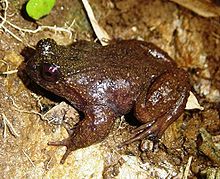Rhinodermatidae
| Rhinodermatidae | |
|---|---|

| |
| Insuetophrynus acarpicus | |
| Scientific classification | |
| Domain: | Eukaryota |
| Kingdom: | Animalia |
| Phylum: | Chordata |
| Class: | Amphibia |
| Order: | Anura |
| Superfamily: | Hyloidea |
| Family: | Rhinodermatidae Bonaparte, 1850 |
| Genera | |
Rhinodermatidae, also known as Darwin's frogs, mouth-breeding frogs or mouth-brooding frogs, is a small family of frogs found in temperate forests of southern Chile and adjacent Argentina.[1]
They are a unique and evolutionary significant group of frogs, being the most basal extant members of the widespread frog superfamily Hyloidea and having branched from the rest during the Late Cretaceous, just a few million years prior to the Cretaceous-Paleogene extinction event. The two genera, Rhinoderma and Insuetophrynus, are thought to have diverged during the Paleocene. Despite their ancient origins, all three species in the family are now endangered due to habitat destruction, invasive species, and especially the spread of chytridomycosis in their native habitats, and one, the Chile Darwin's frog (Rhinoderma rufum), may already be extinct.[2]
Genera[edit]
There are two genera recognised with three species:
- Insuetophrynus Barrio, 1970 (monotypic)
- Rhinoderma Duméril and Bibron, 1841 (2 species)
References[edit]
- ^ "Rhinodermatidae Bonaparte, 1850 | Amphibian Species of the World". research.amnh.org. Retrieved 2020-01-26.
- ^ Feng, Yan-Jie; Blackburn, David C.; Liang, Dan; Hillis, David M.; Wake, David B.; Cannatella, David C.; Zhang, Peng (2017-07-18). "Phylogenomics reveals rapid, simultaneous diversification of three major clades of Gondwanan frogs at the Cretaceous–Paleogene boundary". Proceedings of the National Academy of Sciences. 114 (29): E5864–E5870. doi:10.1073/pnas.1704632114. ISSN 0027-8424. PMC 5530686. PMID 28673970.
